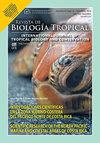Mitochondrial DNA supports the low genetic diversity of Tursiops truncatus (Artiodactyla: Delphinidae) in Bocas del Toro, Panama and exhibits new Caribbean haplotypes
IF 0.6
4区 生物学
Q4 BIOLOGY
引用次数: 0
Abstract
Introduction: The common bottlenose dolphin (Tursiops truncatus) is one of the most studied cetaceans worldwide; however, information about the genetic structure of wild populations is scarce in some regions like Central America and the Caribbean. There are two known genetic forms identified in the Caribbean based on mitochondrial DNA Control Region (mtDNA-CR) data: the ‘inshore (or coastal) form’ and the ‘Worldwide distributed form’. In general, the inshore form refers to coastal and highly philopatric populations that show low genetic diversity. Worldwide distributed form refers to highly mobile populations with coastal and oceanic individuals that do not show philopatry and usually display high genetic diversity. Objective: To determine the preliminary genetic status of common bottlenose dolphins in La Guajira, Colombian Caribbean, using a hypervariable portion of mtDNA-CR. The obtained haplotypes were compared with samples collected in Panama (likely ‘inshore form’) and with haplotypes previously found in other areas of the Caribbean. Methods: In 2016, a total of 26 skin samples were obtained by remote biopsy system (PAXARMS) in two locations, La Guajira (Colombia, N=7) and Bocas del Toro (Panama, N=19). DNA was extracted, samples sexed, and a segment of mtDNA-CR (~550-750 bp) was amplified by PCR. The successfully amplified DNA sequences were manually reviewed and cleaned, and subsequently compared with 44 haplotypes previously reported for the Caribbean. Results: The mtDNA-CR sequences from Bocas del Toro shared the same unique inshore haplotype previously reported for this population, while the samples from La Guajira represented six novel haplotypes, five belonging to the Worldwide distributed form and one to the ‘inshore form.’ Population structure analysis revealed two phylogroups for the Caribbean (FST=0.1353, ΦST=0.3330) with high haplotype diversity: Panama(Bocas del Toro)-Bahamas-Cuba-Mexico (h=0.8489, π=4.2536 %) and Colombia-Costa Rica-Honduras-Puerto Rico (h=0.8837, π=4.2423 %). Conclusions: These findings support the results previously reported for common bottlenose dolphins in Bocas del Toro-Panama and reinforce the need to protect this vulnerable ‘inshore’ population by treating it as a unique population management unit. Mitochondrial DNA analysis of samples collected from La Guajira dolphins provide the first insight into the genetic diversity of common bottlenose dolphins in this region, indicating the presence of both inshore and Worldwide distributed genetic forms. The potential connectivity of this last form among La Guajira-Colombia, Costa Rica, and Honduras in Central America highlights the need for more genetic and ecological studies to determine the appropriate management units for this species in Central America and the Caribbean.线粒体DNA支持巴拿马博卡斯德尔托罗的truncatus(偶蹄目:海豚科)的低遗传多样性,并显示出新的加勒比单倍型
简介:常见的宽吻海豚(Tursiops truncatus)是世界上研究最多的鲸目动物之一;然而,在中美洲和加勒比等一些地区,关于野生种群遗传结构的信息很少。根据线粒体DNA控制区(mtDNA-CR)数据,在加勒比地区发现了两种已知的遗传形式:“近岸(或沿海)形式”和“全球分布形式”。一般来说,近岸形式指的是沿海和高度亲和性的种群,遗传多样性低。全球分布形式是指具有沿海和海洋个体的高流动性种群,不表现出亲缘性,通常表现出高度遗传多样性。
目的:利用mtDNA-CR的高变部分,初步确定哥伦比亚加勒比海拉瓜希拉地区常见宽吻海豚的遗传状况。获得的单倍型与在巴拿马收集的样本(可能是“近海形式”)以及先前在加勒比其他地区发现的单倍型进行了比较。方法:2016年,在哥伦比亚La Guajira (N=7)和巴拿马Bocas del Toro (N=19)两个地点,通过远程活检系统(PAXARMS)获得26份皮肤样本。提取DNA,对样品进行性别鉴定,用PCR扩增出一段mtDNA-CR (~550 ~ 750bp)。成功扩增的DNA序列被人工检查和清理,随后与先前报道的加勒比地区的44个单倍型进行比较。结果:来自Bocas del Toro的mtDNA-CR序列与先前报道的该人群的独特近海单倍型相同,而来自La Guajira的样本则代表了6个新的单倍型,其中5个属于全球分布形式,1个属于“近海形式”。种群结构分析显示,加勒比地区有两个类群(FST=0.1353, ΦST=0.3330)具有高单倍型多样性:巴拿马(Bocas del Toro)-巴哈马-古巴-墨西哥(h=0.8489, π= 4.2536%)和哥伦比亚-哥斯达黎加-洪都拉斯-波多黎各(h=0.8837, π= 4.2423%)。
结论:这些发现支持了之前对博卡斯德尔托罗-巴拿马常见宽吻海豚的报道结果,并加强了通过将其视为独特的种群管理单元来保护这一脆弱的“近海”种群的必要性。对从瓜希拉海豚身上采集的样本进行线粒体DNA分析,首次深入了解了该地区常见宽吻海豚的遗传多样性,表明它们存在近海和全球分布的遗传形式。最后一种形式在中美洲的瓜希拉-哥伦比亚、哥斯达黎加和洪都拉斯之间的潜在连通性突出表明,需要进行更多的遗传和生态研究,以确定中美洲和加勒比地区该物种的适当管理单位。
本文章由计算机程序翻译,如有差异,请以英文原文为准。
求助全文
约1分钟内获得全文
求助全文
来源期刊

Revista De Biologia Tropical
生物-生物学
CiteScore
1.80
自引率
0.00%
发文量
23
审稿时长
4-8 weeks
期刊介绍:
The Revista de Biología Tropical / International Journal of Tropical Biology and Conservation is a mainstream scientific journal published since 1953 and covered by Web of Science; Science Citation Index; Current Contents; Google Scholar; Scopus, SciELO and nearly 50 additional indices.
A double blind system guarantees you a fair evaluation, and our world class editorial and scientific boards provides a first decision in three working days. The journal is Full Open Access and is widely read where your article can have the highest real impact.
Since its beginning in 1953, the Revista follows these principles: objective and independent evaluation of all manuscripts; transparency in all processes; ethical use of procedures, data, specimens and subjects; fair treatment of all parties; and absolute predominance of scientific rigor over any other aspect.
 求助内容:
求助内容: 应助结果提醒方式:
应助结果提醒方式:


